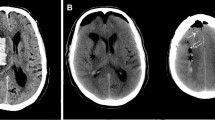Abstract
Purpose
The underlying mechanisms for cerebral blood flow (CBF) abnormalities in acute bacterial meningitis (ABM) are largely unknown. Putative mediators include vasoactive peptides, e.g. calcitonin-gene related peptide (CGRP), vasoactive intestinal peptide (VIP), and endothelin-1 (ET-1), all of which may be affected by therapeutic interventions used in the intensive care unit. We measured arterial levels as well as the net cerebral flux of these peptides in patients with ABM, and in healthy volunteers undergoing interventions relevant to intensive care.
Methods
Seven patients with severe ABM and sepsis and fifteen healthy volunteers were included after informed consent. The net cerebral fluxes of vasoactive peptides were measured by the Kety-Schmidt technique in ABM patients (baseline study only), as well as in volunteers at baseline, during voluntary hyperventilation, after an intravenous injection of lipopolysaccharide (LPS), and during norepinephrine infusion.
Results
The arterial levels of CGRP, but not of VIP or ET-1, were elevated in patients with ABM, but no net cerebral flux was present. CGRP levels decreased during hyperventilation and after LPS injection. No net cerebral flux of VIP occurred in any group at any time. A cerebral efflux of ET-1, which occurred in volunteers at baseline, was neither present in volunteers after LPS injection nor in patients with ABM.
Conclusion
The arterial concentration of the vasodilatory peptide, CGRP, but of neither VIP nor the vasoconstrictor ET-1, is elevated in patients with ABM and sepsis. A constitutive cerebral output of ET-1 appears to be present in healthy humans, but is abolished after LPS injection.
Similar content being viewed by others
References
Scheld WM, Koedel U, Nathan B, Pfister HW (2002) Pathophysiology of bacterial meningitis: mechanism(s) of neuronal injury. J Infect Dis 186(Suppl 2):S225–S233
Pfister LA, Tureen JH, Shaw S, Christen S, Ferriero DM, Täuber MG, Leib SL (2000) Endothelin inhibition improves cerebral blood flow and is neuroprotective in pneumococcal meningitis. Ann Neurol 47:329–335
Uddman R, Edvinsson L (1989) Neuropeptides in the cerebral circulation. Cerebrovasc Brain Metab Rev 1:230–252
Hoffmann O, Keilwerth N, Bille MB, Reuter U, Angstwurm K, Schumann RR, Dirnagl U, Weber JR (2002) Triptans reduce the inflammatory response in bacterial meningitis. J Cereb Blood Flow Metab 22:988–996
Brandtzaeg P, Oktedalen O, Kierulf P, Opstad PK (1989) Elevated VIP and endotoxin plasma levels in human gram-negative septic shock. Regul Pept 24:37–44
Koedel U, Gorriz C, Lorenzl S, Pfister HW (1997) Increased endothelin levels in cerebrospinal fluid samples from adults with bacterial meningitis. Clin Infect Dis 25:329–330
Bone RC, Balk RA, Cerra FB, Dellinger RP, Fein AM, Knaus WA, Schein RM, Sibbald WJ (1992) Definitions for sepsis and organ failure and guidelines for the use of innovative therapies in sepsis: the ACCP/SCCM Consensus Conference Committee. American College of Chest Physicians/Society of Critical Care Medicine. Chest 101:1644–1655
Møller K, Strauss GI, Qvist J, Fonsmark L, Knudsen GM, Larsen FS, Krabbe KS, Skinhøj P, Pedersen BK (2002) Cerebral blood flow and oxidative metabolism during human endotoxemia. J Cereb Blood Flow Metab 22:1262–1270
Møller K, Qvist T, Tofteng F, Sahl C, Sønderkær S, Dethloff T, Knudsen GM, Larsen FS (2004) Cerebral blood flow and metabolism during infusion of norepinephrine and propofol in patients with bacterial meningitis. Stroke 35:1333–1339
Schifter S (1991) Circulating concentrations of calcitonin gene-related peptide (CGRP) in normal man determined with a new, highly sensitive radioimmunoassay. Peptides 12:365–369
Fahrenkrug J, Schaffalitzky de Muckadell OV (1977) Radioimmunoassay of vasoactive intestinal polypeptide (VIP) in plasma. J Lab Clin Med 89:1379–1388
Fick A (1870) Über die Messung des Blutquantums in den Herzventrikeln. Verh Phys Med Ges Würzburg 2:16
Arnalich F, Hernanz A, Jimenez M, Lopez J, Tato E, Vazquez JJ, Montiel C (1996) Relationship between circulating levels of calcitonin gene-related peptide, nitric oxide metabolites and hemodynamic changes in human septic shock. Regul Pept 65:115–121
Beer S, Weighardt H, Emmanuilidis K, Harzenetter MD, Matevossian E, Heidecke CD, Bartels H, Siewert JR, Holzmann B (2002) Systemic neuropeptide levels as predictive indicators for lethal outcome in patients with postoperative sepsis. Crit Care Med 30:1794–1798
Linscheid P, Seboek D, Schaer DJ, Zulewski H, Keller U, Muller B (2004) Expression and secretion of procalcitonin and calcitonin gene-related peptide by adherent monocytes and by macrophage-activated adipocytes. Crit Care Med 32:1715–1721
Acknowledgments
Supported by grants from The Foundation in Commemoration of Holger and Ruth Hesse, The Foundation for Clinical Research in Copenhagen Hospital Corporation, The AP Møller Foundation, The Larsen Foundation, The Skovgaard Foundation, The Hørslev Foundation, The University of Copenhagen, The Danish National Health Research Council, The Laerdal Foundation, The Maigaard Foundation, The Novo Nordisk Foundation, The P. Carl Pedersen Foundation, and The Gangsted Foundation. The Centre of Inflammation and Metabolism is supported by grants from the Danish National Research Foundation (DG 02-512-555) and the Commission of the European Communities (contract no. LSHM-CT-2004-005272 EXGENESIS).
Conflict of interest statement
None.
Author information
Authors and Affiliations
Corresponding author
Rights and permissions
About this article
Cite this article
Berg, R.M.G., Strauss, G.I., Tofteng, F. et al. Circulating levels of vasoactive peptides in patients with acute bacterial meningitis. Intensive Care Med 35, 1604–1608 (2009). https://doi.org/10.1007/s00134-009-1515-3
Received:
Accepted:
Published:
Issue Date:
DOI: https://doi.org/10.1007/s00134-009-1515-3




